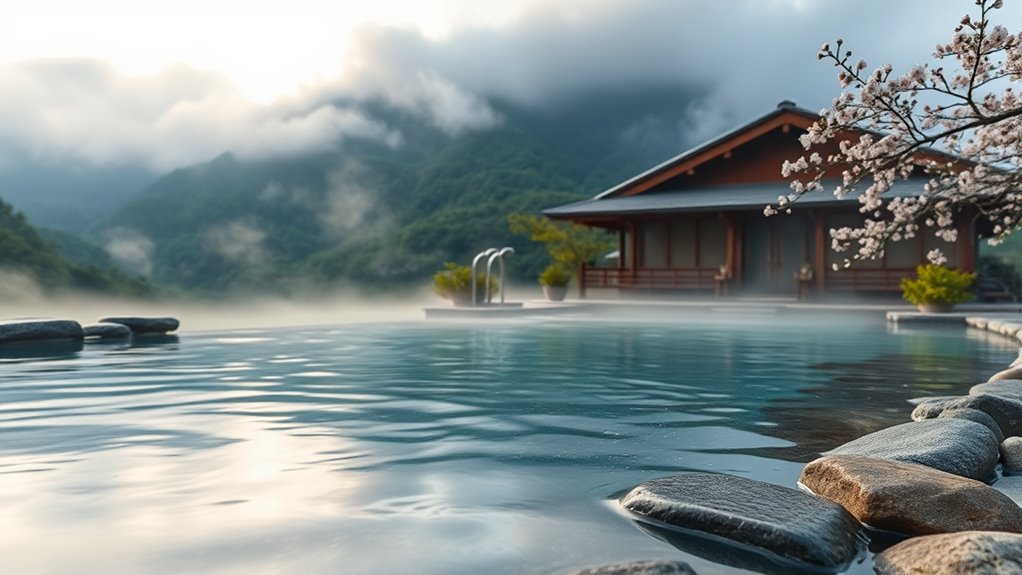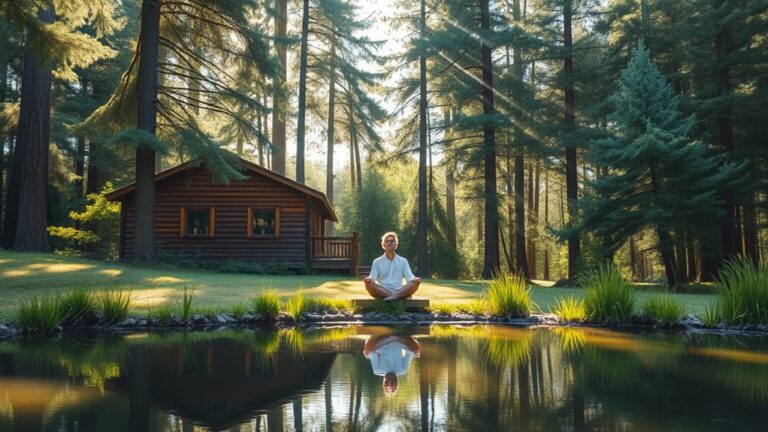Hot springs and onsens in Japan aren’t just about relaxation; they’re steeped in history and culture. These mineral-rich waters offer therapeutic benefits, believed to purify both body and soul. You’ll find a variety of onsens, from serene outdoor baths surrounded by nature to cozy indoor spaces. With unique rituals and etiquette, visiting an onsen becomes a mindful experience. Discover how these ancient sanctuaries impact wellness and tourism in Japan, and much more waits to be uncovered.
Nomad Highlights
- Onsens, traditional Japanese hot springs, have historical roots in wellness and spirituality, enhancing relaxation and cultural identity.
- The mineral-rich waters of onsens offer therapeutic benefits, promoting overall health and well-being.
- Bathing etiquette and guidelines enhance the communal experience, emphasizing respect and mindfulness in the onsen environment.
- Outdoor and indoor onsens provide unique ambiances, catering to different preferences for scenery and tranquility.
- Sustainable practices in onsen management support environmental conservation and contribute to local economies through tourism.
The History of Onsen in Japan
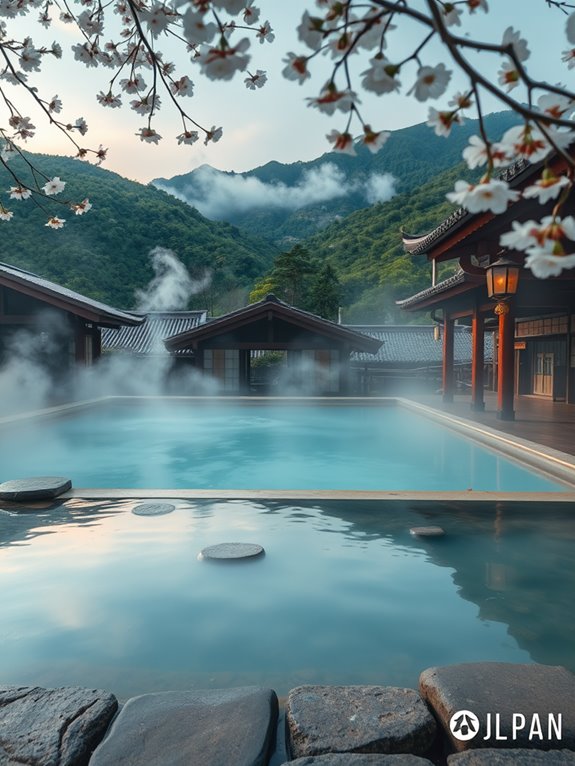
Since ancient times, Japan’s onsens have captivated visitors with their natural beauty and healing properties. These thermal baths, steeped in historical significance, trace their roots back to the Nara period, where they served not only as places for relaxation but also as communal hubs. You’ll discover that ancient traditions surrounding onsens emphasize wellness and spirituality, with rituals often linked to Shinto beliefs. Bathing in these mineral-rich waters was believed to purify both body and soul. As you explore onsens today, you’re walking in the footsteps of emperors and monks who cherished these sanctuaries. Their time-honored practices continue to inspire modern wellness trends, blending the past with present-day innovations in health and relaxation. Additionally, the use of acupressure mats has emerged as a popular method for enhancing relaxation and promoting overall well-being. These mats, which promote muscle relaxation through gentle pressure, are now embraced by many as a complementary practice to traditional bathing. In fact, the practice of thermal bathing has been linked to various health benefits, including improved circulation and stress relief. The unique properties of mineral-rich waters found in onsens are believed to contribute significantly to the therapeutic effects experienced by bathers. Furthermore, many contemporary stress management techniques, including those found in stress management workbooks, draw upon ancient practices that promote mindfulness and emotional balance.
Types of Onsen and Their Unique Features
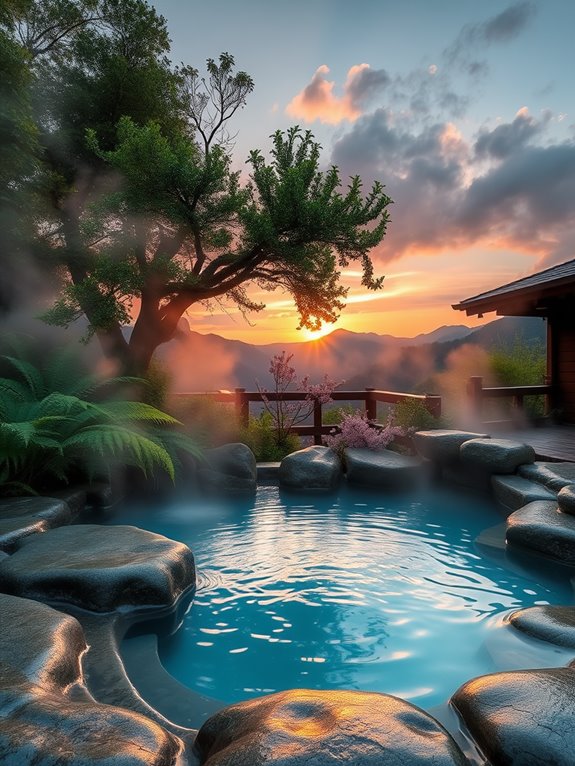
When you step into an onsen, you’re greeted by a world of unique experiences shaped by natural mineral content. You’ll find a delightful contrast between the serene tranquility of outdoor baths, often surrounded by nature, and the cozy intimacy of indoor ones. Each type offers distinct benefits, making your choice an exciting part of the journey. Additionally, the healing properties of minerals found in onsen water can enhance relaxation and rejuvenation. The diverse mineral compositions can have various health benefits, such as improving skin conditions and relieving muscle tension. Furthermore, many visitors enjoy sipping caffeine-free herbal tea post-bath to further promote relaxation and well-being. Many onsen experiences also include access to guided meditation scripts, which can enhance the overall tranquility of the visit. The unique mineral content in each onsen can impact skin health significantly, offering tailored benefits depending on the specific minerals present.
Natural Mineral Content
Japan’s onsens, or hot springs, boast a rich tapestry of natural mineral content, each type offering unique therapeutic benefits and experiences.
You’ll find sulfur-rich waters that can help with skin ailments and respiratory issues, while iron-infused springs promote circulation and alleviate fatigue. The mineral composition of each onsen influences its color, scent, and healing properties. Additionally, many onsens utilize advanced filtration systems to ensure the purity of their waters, enhancing the overall experience for visitors. Engaging in stress-relief coloring activities can further complement the relaxation achieved through these therapeutic baths. Furthermore, understanding the quality and characteristics of essential oils can enhance your overall wellness experience when combined with onsen visits. Research has shown that the use of multi-layer insulation in some wellness products can enhance their effectiveness, similar to how layered mineral compositions benefit onsens.
For example, sodium bicarbonate baths soften your skin, making them a favorite for beauty enthusiasts. In contrast, magnesium-rich waters are renowned for their calming effects, perfect for relieving stress. Additionally, many onsens are known for their unique product offerings that cater to various wellness needs.
As you immerse yourself in these mineral-laden waters, you’ll not only enjoy relaxation but also harness their powerful therapeutic effects, enhancing your overall wellness in a truly innovative way.
Indoor vs. Outdoor Baths
The experience of soaking in an onsen can vary greatly depending on whether you choose an indoor or outdoor bath.
Indoor baths offer a serene ambiance, often adorned with natural materials like wood and stone, creating a tranquil space to unwind. Here, you can enjoy the soothing warmth while escaping the world outside. Additionally, the clean air quality provided by air purifiers can enhance your indoor bathing experience. The use of natural elements in indoor designs further contributes to a calming atmosphere. Furthermore, the durable materials used in constructing indoor baths ensure they remain a peaceful retreat for years to come. Indoor environments can also benefit from high-quality sounds that improve relaxation, similar to how white noise machines enhance sleep.
On the other hand, outdoor baths immerse you in breathtaking scenery. Picture yourself soaking in steaming waters surrounded by lush forests or majestic mountains, where nature’s beauty enhances your relaxation. Both options provide unique benefits, but your choice hinges on whether you seek the calming indoor ambiance or the invigorating connection with outdoor scenery. Additionally, the benefits of personal air purifiers can enhance your overall relaxation experience during your stay by ensuring clean air in your surroundings.
Whatever you select, both promise a rejuvenating experience like no other.
The Healing Benefits of Hot Springs
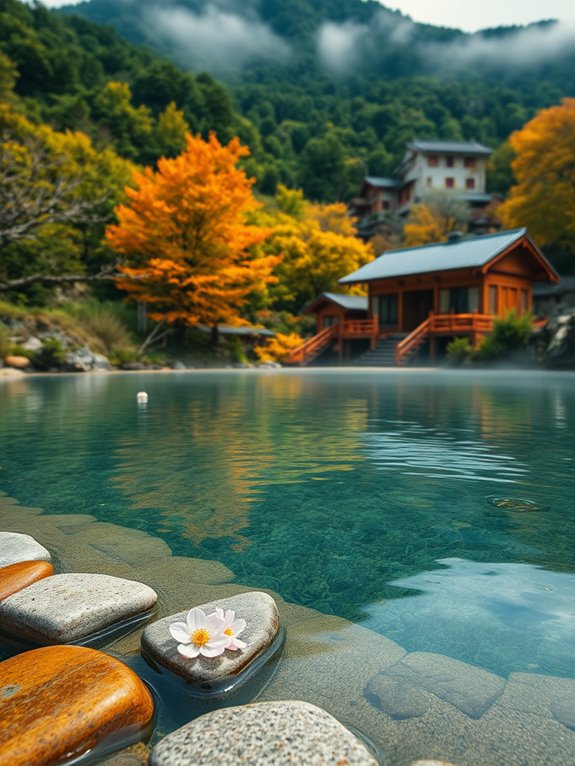
As you soak in the steaming waters of a Japanese hot spring, your body embraces a wave of relaxation that transcends mere luxury.
The therapeutic properties of the mineral-rich waters work wonders on your skin, muscles, and joints, easing tension and promoting overall wellness. You can feel the warmth penetrating deep into your body, melting away stress and fatigue like ice on a sunny day. The use of meditation cushions can further enhance your relaxation experience by providing optimal support during your time of mindfulness. Additionally, the calming effects of singing bowls can complement your hot spring experience, promoting deeper relaxation and mindfulness. Engaging in these practices can lead to a greater sense of holistic well-being, allowing you to fully embrace the rejuvenating effects of the hot springs. Recent studies show that soaking in hot springs can also boost immune function and improve overall health.
Each breath fills your lungs with the fresh, crisp air, enhancing your sense of tranquility. The soothing ambiance invites you to let go of worries, allowing mindfulness to take hold.
Discovering these natural hot springs offers not just physical rejuvenation but also emotional healing, making every visit an innovative step toward holistic well-being. Additionally, engaging in such restorative practices can significantly reduce anxiety levels, similar to the effects of coloring books as a therapeutic tool for stress relief.
Cultural Etiquette and Practices at Onsen
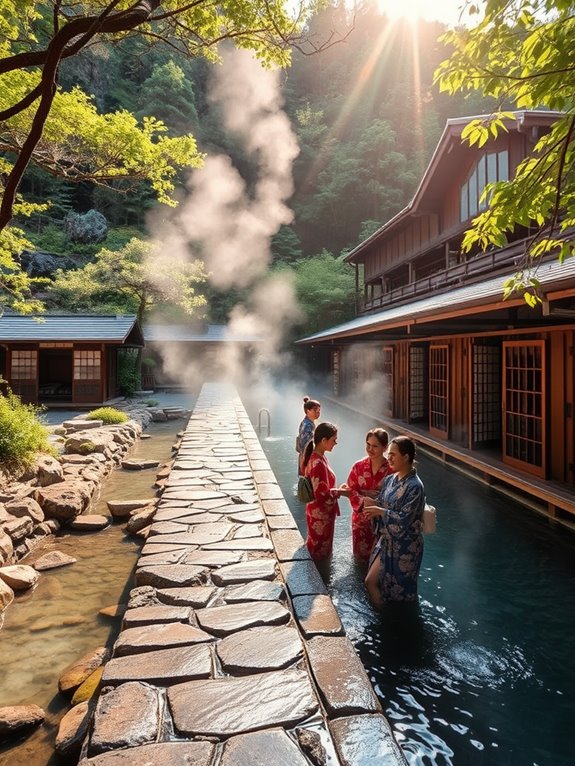
When you step into an onsen, you’re entering a world rich with tradition and respect. You’ll need to follow specific bathing etiquette and clothing guidelines to fully appreciate this unique experience. From rinsing off before soaking to knowing what to bring—or leave behind—let’s explore the essential practices that will make your visit smooth and enjoyable. Additionally, being aware of cultural etiquette can enhance your overall onsen experience and ensure you respect local customs. Many onsens also offer unique products that cater to the various passions of visitors, adding to the overall enjoyment of your visit. The experience is often enhanced by thermal bath benefits, which can soothe both body and mind. Furthermore, the tranquility provided by quiet operation in many onsens allows guests to relax without distractions. It’s also important to remember that onsen etiquette includes refraining from bringing towels into the water, ensuring a clean and respectful environment for all bathers.
Bathing Etiquette Rules
While immersing yourself in the soothing waters of an onsen, it’s vital to respect the bathing etiquette that enhances the experience for everyone.
Here are some essential etiquette tips to keep in mind as you embrace Japan’s bathing customs:
- Wash Thoroughly: Before entering the communal baths, rinse your body at the shower stations, making sure you’re clean. This practice is similar to ensuring stability and durability in tablet stands, which emphasizes the importance of preparation. Maintaining cleanliness is also crucial for ensuring a comfortable sleep environment in your own home. Additionally, using natural essential oils in your post-bath routine can further enhance your relaxation. Remember, regular cleaning of your bathing area is essential to prevent any buildup of dirt and bacteria, similar to the maintenance required for portable humidifiers.
- Quiet Enjoyment: Keep conversations hushed to maintain a tranquil atmosphere; the onsen is a place for relaxation.
- Towel Management: Never bring your towel into the bath; leave it on the side or place it on your head.
- Mindful Entry: Enter the onsen slowly, allowing your body to adjust to the temperature before fully submerging.
Additionally, many onsens offer unique thermal bath experiences that can enhance your relaxation and wellness journey.
Following these guidelines will guarantee a peaceful and rejuvenating experience for everyone involved.
Clothing and Towel Guidelines
Understanding the clothing and towel guidelines at an onsen is essential for a respectful and enjoyable experience. In most onsens, swimwear restrictions are strict; nudity is the norm, allowing you to fully embrace the natural surroundings.
Before entering the bath, you’ll need to wash thoroughly, ensuring cleanliness for everyone. As for towel usage, you should bring a small towel for modesty while walking to the bath, but remember—don’t bring it into the water! Instead, place it on the side or on your head for convenience.
Embrace the freedom of the onsen experience by following these simple guidelines, enhancing your connection with nature and the rich cultural heritage of Japan’s thermal baths.
Popular Onsen Destinations Across Japan
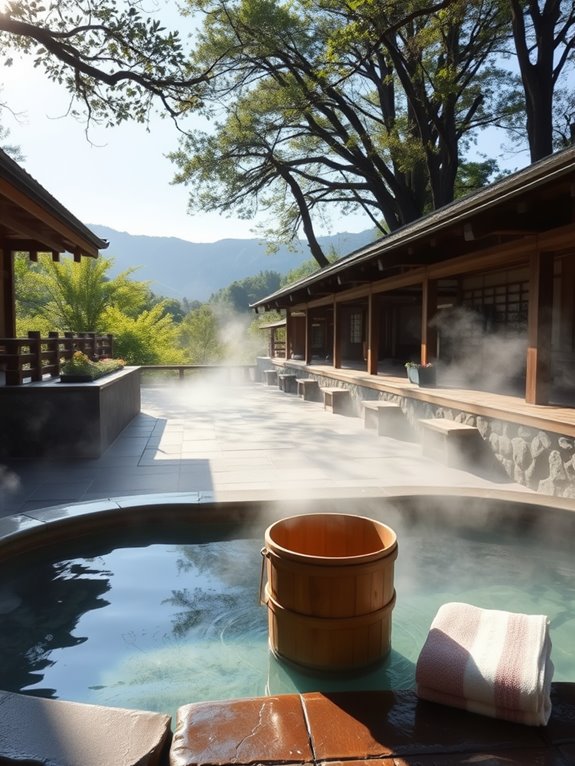
As you explore Japan, you’ll discover that its onsen destinations offer a unique blend of natural beauty and cultural richness. Here are some must-visit locations:
- Hakone resorts: Nestled in the mountains, enjoy stunning views of Mount Fuji while soaking in mineral-rich waters.
- Beppu attractions: Famous for its “Hells”, this city showcases diverse hot springs, each with its own unique features.
- Kinosaki experiences: Stroll through charming streets lined with traditional ryokans, bathing in multiple public baths adorned with wooden architecture.
- Noboribetsu highlights: Explore this volcanic area, where sulfuric steam rises from the earth, offering therapeutic waters and rich folklore.
Don’t forget to indulge in Gero traditions and embrace Ibusuki uniqueness for an unforgettable onsen experience.
The Future of Onsen and Sustainable Tourism
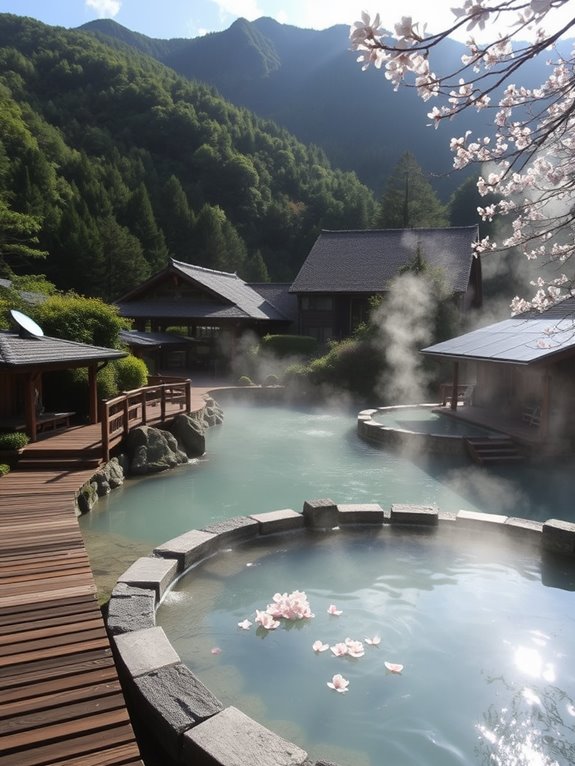
With the growing emphasis on sustainable tourism, Japan’s onsen culture is evolving to meet modern expectations while preserving its rich heritage.
You’ll find that many onsen are adopting eco-friendly practices, like utilizing solar energy for heating and recycling water to minimize waste. This commitment not only reduces their environmental impact but also attracts visitors who prioritize sustainability.
Community involvement plays an essential role in this transformation. Local residents are getting engaged, hosting workshops and events that educate visitors about the cultural significance of onsens and the importance of conservation.
Frequently Asked Questions
Can Children Visit Onsen, or Are There Age Restrictions?
You’ll find that many onsen welcome children, but it’s important to know the etiquette. Some facilities have age restrictions or designated family-friendly options.
When visiting, make sure your little ones understand the rules—like washing before entering and keeping noise levels down.
Look for places with private baths, which can make the experience more enjoyable for your family. Exploring these thermal baths together can be a unique bonding experience that everyone will cherish!
What Should I Bring to an Onsen for Personal Use?
When you visit an onsen, you’ll want to pack a few essentials for personal use.
Consider towel options like a quick-dry travel towel or a lightweight cotton one.
Don’t forget your bathing attire—something comfortable and suitable for soaking.
A water bottle is handy to stay hydrated, while flip-flops make for easy movement.
Finally, bring a small bag for your belongings.
With these items, you’re all set for a relaxing experience!
Are Tattoos Allowed in Onsen Facilities?
When you’re considering a visit to an onsen, you might wonder about tattoo policies and cultural attitudes surrounding them.
Some facilities strictly ban tattoos, associating them with gang culture, while others embrace a more inclusive approach.
You’ll find that certain places allow tattoos, especially if you cover them up.
Researching ahead guarantees you choose a welcoming environment, allowing you to fully enjoy the relaxing experience without any concerns about your body art.
How Do Onsen Affect Skin Conditions or Allergies?
Onsen baths offer remarkable thermal healing properties that can greatly benefit your skin.
When you soak in the mineral-rich waters, you’ll notice improved hydration and reduced irritation. The natural elements work wonders for conditions like eczema and psoriasis, soothing inflammation and promoting healing.
Plus, the warmth helps open your pores, allowing your skin to absorb these nutrients deeply. Embracing this unique experience can truly transform your skin and enhance your overall well-being.
Is It Necessary to Book Onsen Visits in Advance?
It’s often a good idea to book onsen visits in advance, especially during peak seasons when popularity soars.
Many facilities have specific booking policies to manage demand, ensuring you secure your spot.
By planning ahead, you not only guarantee your experience but also get to choose the best times and services.
Enjoying a serene soak in a tranquil setting is worth the little extra effort to arrange your visit ahead of time.
Conclusion
As you soak in the mineral-rich waters of Japan’s hot springs, you’re not just relaxing; you’re embracing centuries of tradition and healing. Each bubbling pool invites you to unwind, washing away the worries of the world like waves eroding a sandy shore. The warmth seeps into your bones, igniting a sense of connection to nature and culture that’s as deep as the springs themselves. By choosing onsen, you’re not just indulging; you’re partaking in a timeless ritual that rejuvenates body and spirit.

